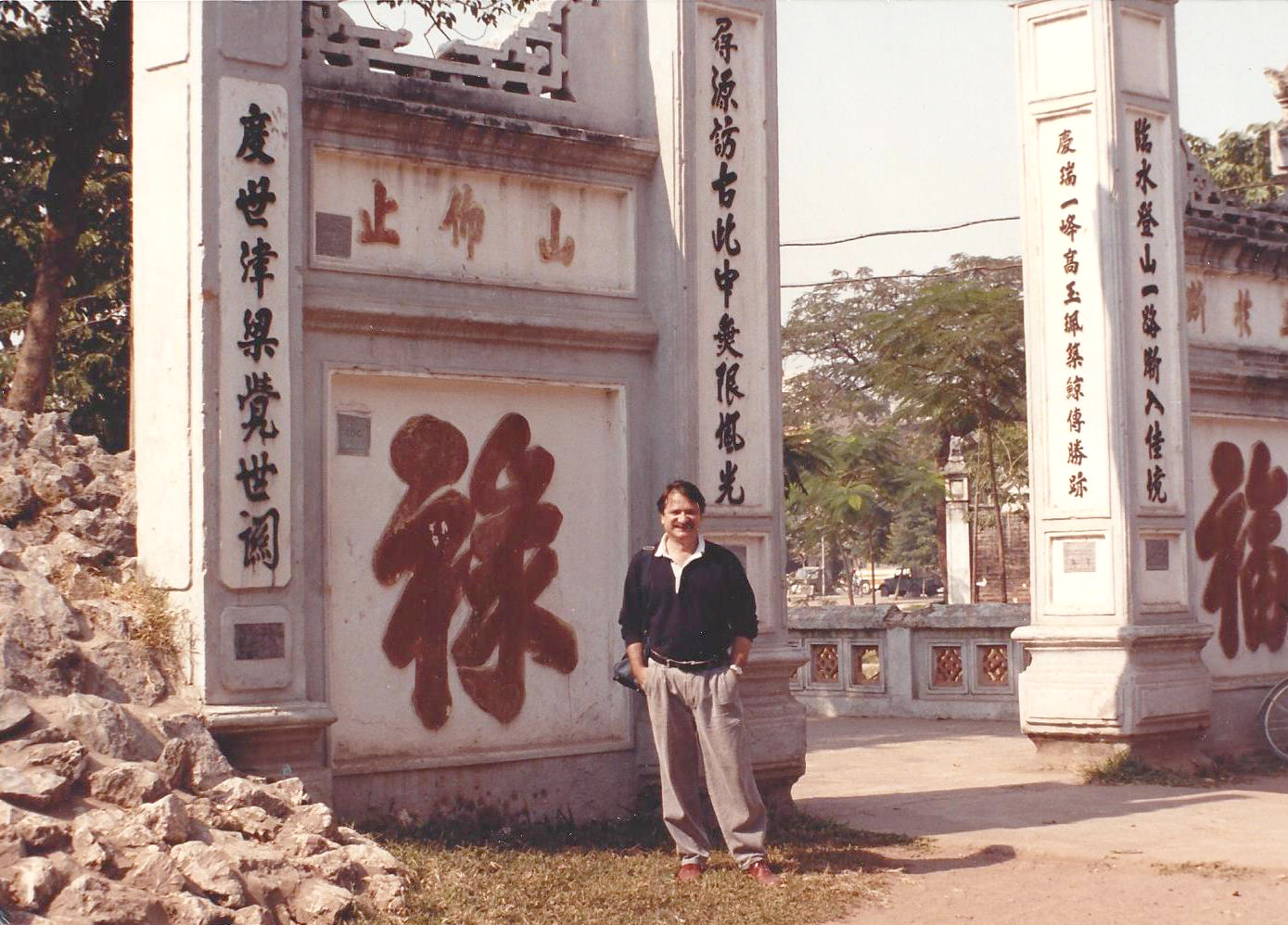Rescuing a Script from Extinction
Editor’s Note: Earlier versions of this article appeared in our print magazine, Accolades, and online.
After trending toward extinction for decades, Vietnam’s ancient script, Chữ Nôm, now has a healthier outlook.
With a few strokes on the keyboard, anyone with a computer can write in Nôm. The character 字, for instance, represents the Nôm word for “word.”
In addition, thousands of documents written in Nôm are being translated and digitized. Scholars have published Nôm dictionaries, and online look-up tools allow users to find the Nôm translations of words they know.
NC State English professor John Balaban has helped lead many of the developments that kickstarted Nôm’s recovery, turning an endangered calligraphic way of writing into a preserved tradition.
From translating the first Nôm book to be printed on a printing press to working with other scholars to create the Vietnamese Nôm Preservation Foundation, which continues to digitize texts today, Balaban’s initial interest in Vietnamese poetry has transformed into an admiration of the nation’s ancient culture.
In this photo from 1969, John Balaban carries a child while volunteering for the Committee of Responsibility to Save War Burned and War Injured Vietnamese Children. Photo courtesy of John Balaban.
The Vietnamese relics, photographs and writings that abound in Balaban’s home give some insight into his fondness for the country and its people. They’ll remain there even as he takes a step back from his work with the Nôm Preservation Foundation and retires from his position at NC State.
Balaban has served as a professor of English for nearly 45 years at various institutions. He’s spent the past 15 years at NC State, where he’s also served as the university’s poet-in-residence.
A recipient of the Academy of American Poets’ Lamont Prize, the Poetry Society of America’s William Carlos Williams Award and a Guggenheim Fellowship, Balaban is a two-time nominee for the National Book Award. His work has also been selected for the National Poetry Series. He’s written 12 books of poetry and prose, many of which address his time in Vietnam.
Balaban first traveled to the country in 1967 as a conscientious objector during the Vietnam War. After teaching linguistics for a year at the University of Can Tho, he volunteered as a field representative for a group that helped evacuate war-injured children.
“Our job was to get them out of Vietnam and get them to hospitals in the United States,” Balaban said. “When they were well enough to come home, we’d bring them back to their families.”
He spent two years volunteering with the Committee of Responsibility to Save War Burned and War Injured Vietnamese Children. It was during that time — even amid tragedy — that he started to hear poetry coming from the countryside.
“I’d be at a river crossing, waiting for a ferry to take me to the other side, and there’d sometimes be a blind person, led by a little boy, singing this old poetry,” Balaban recalled. “Sometimes there’d be a boat going by, and there’d be a woman singing.”
The Vietnamese he met would not only sing the oral folk poetry known as ca dao, Balaban said; they would also reference it in debate and while telling stories.
I’d be at a river crossing, waiting for a ferry to take me to the other side, and there’d sometimes be a blind person, led by a little boy, singing this old poetry. Sometimes there’d be a boat going by, and there’d be a woman singing.
— John Balaban
Fascinated by what he was hearing, Balaban returned to Vietnam in 1971 to capture the poetry on tape. Through a National Endowment for the Humanities grant, he spent a year recording farmers largely in and around the Mekong Delta. He transcribed the recordings into Vietnamese and published them — poems that for the most part had never appeared in print anywhere.
Spring Essence
While recording this poetry, Balaban often talked with locals about literature in general. Some suggested names of writers he should translate. An 18th-century poet who came up quite often, Hồ Xuân Hương, wrote in Nôm.
The Vietnamese had written in Chinese since the first century A.D. That changed around the year 1000, after Vietnam won independence from China and developed its own writing system, Nôm, which was similar to Chinese but adapted to the Vietnamese language.
Nôm served as the national vernacular script until the French colonizers of Vietnam forbade its use in 1920. As modern Vietnamese writing, quốc ngữ, became more prominent, fewer and fewer people knew how to read the old script. In addition, the Nôm texts that already existed were printed by woodblock, hand-carved or hand-inked, relegating the text to materials that often weren’t preserved and to which few people had access.
Nom’s trend toward obsolescence started to reverse when Balaban began translating Hương’s poetry. Balaban worked with New York University professor Ngô Thanh Nhàn, who created a TrueType font for Nôm. That development allowed the ancient script to be keyed into a computer, leading to the first typographic printing of Nôm in Balaban’s book Spring Essence: The Poetry of Hồ Xuân Hương. The Nôm poems appeared alongside Balaban’s translations.
Nôm preservation
Spring Essence was published in 2000, the same year Balaban started teaching at NC State. The newly created Nom Na Tong TrueType font unlocked the possibility to translate, reprint and digitize nearly 1,000 years of Nôm writings stored largely in libraries and temples around the world.

John Balaban outside the Ngoc Son Temple in Hanoi, Vietnam, in 1989. Photo courtesy of John Balaban.
To try to preserve as many of those writings as possible, Balaban and several other scholars founded the Vietnamese Nôm Preservation Foundation. The group, consisting of Nôm experts from around the world, has helped translate thousands of documents while encouraging others to preserve the tradition.
At the Vietnamese national library in Hanoi, for example, Balaban and other scholars started working in 2007 to digitize more than 4,000 Nôm writings, many of which were literally being eaten by bookworms.
The group’s work has extended to temples, where the foundation is preserving not only texts but also stone inscriptions, murals, placards and architecture.
“In the Communist era, a lot of temples were destroyed. These materials are important because no scholars have looked at them before,” Balaban said. “People understand the idea of digitizing a text, but the idea of digitizing a whole space has vast cultural value as well.”
Through the Nôm Preservation Foundation, Balaban has also helped Nôm scholars publish dictionaries and online resources for translation. A look-up tool on the foundation’s website allows anyone to search in Vietnamese or English for Nôm terms for anything from broad concepts such as “peace” (憺) and “love” (恋) to more specific words like “water chestnut” (荸) and “brindled ox” (犖).
Perhaps fewer than 100 scholars around the world can read Nôm. Balaban, who received the medal of appreciation from Vietnam Ministry of Culture, Sports and Tourism for his work, said he can only follow the ancient script in modern Vietnamese transcription.
And while Balaban now plans to scale back his involvement with the Nôm Foundation, his legacy will live on through an annual endowment award in his name. Since 2009, the foundation has given the Balaban Award to individuals who help preserve and propagate the 1,000-year heritage of writings.
The award was named by its benefactors, Dr. Phùng Liên Đoàn, a nuclear physicist, and his wife, Thư Lê, who joined Balaban in helping comfort war-injured children during the Vietnam War. Balaban said he is both embarrassed and pleased that his name is attached to the award, but he’s proud nonetheless that it’s helping Vietnamese scholars continue to preserve writings in the ancient script.
“It’s such an important heritage that needs to be preserved,” Balaban said.
“Because of my background with the war, people try to make my overly long endeavors with this a part of dealing with the war. But if it ever began that way, it didn’t last very long. It’s simply fascinating work.”
Here is a poem by Hồ Xuân Hương, translated to English by John Balaban:
Spring — Watching Pavilion
A gentle spring evening arrives
airily, unclouded by worldly dust.
Three times the bell tolls echoes like a wave.
We see heaven upside down in sad puddles.
Love’s vast sea cannot be emptied.
And springs of grace flow easily everywhere.
Where is nirvana?
Nirvana is here, nine times out of ten.


